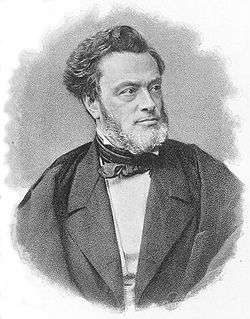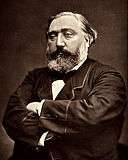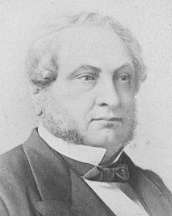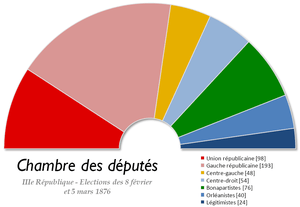French legislative election, 1876
| | |||||||||||||||||||||||||||||||||||||||||||||||
| |||||||||||||||||||||||||||||||||||||||||||||||
| |||||||||||||||||||||||||||||||||||||||||||||||
|
| |||||||||||||||||||||||||||||||||||||||||||||||
| Composition of the Chamber of Deputies | |||||||||||||||||||||||||||||||||||||||||||||||
| |||||||||||||||||||||||||||||||||||||||||||||||
The 1876 general election to the Chamber of Deputies, the lower chamber of the National Assembly of the French Third Republic under the French Constitutional Laws of 1875, was held on 20 February and 5 March 1876.
The result was a victory for the Republicans. President Patrice MacMahon subsequently invited Jules Simon, who declared himself "resolutely republican and resolutely conservative", to form a government, but dismissed him on 16 May 1877, precipitating the Seize Mai crisis and further elections.[1]
75.90% of eligible voters voted.
Results
Parliamentary Groups
| Affiliation | Party | Seats | |
|---|---|---|---|
| Republicans | |||
| Republican Union | 98 | ||
| Republican Left[2] | 193 | ||
| Centre-left[3] | 48 | ||
| Centre-Right | 54 | ||
| Right | |||
| Orleanists | 40 | ||
| Bonapartists | 76 | ||
| Legitimists | 24 | ||
| Total | 533 | ||
- ↑ Gildea, R., Children of the Revolution, London, 2008, p. 252-253
- ↑ Supporters of Jules Ferry, including Jules Grévy, Jules Favre, and Jules Simon
- ↑ Liberal supporters of the Republic
Sources
This article is issued from Wikipedia - version of the 3/4/2016. The text is available under the Creative Commons Attribution/Share Alike but additional terms may apply for the media files.



